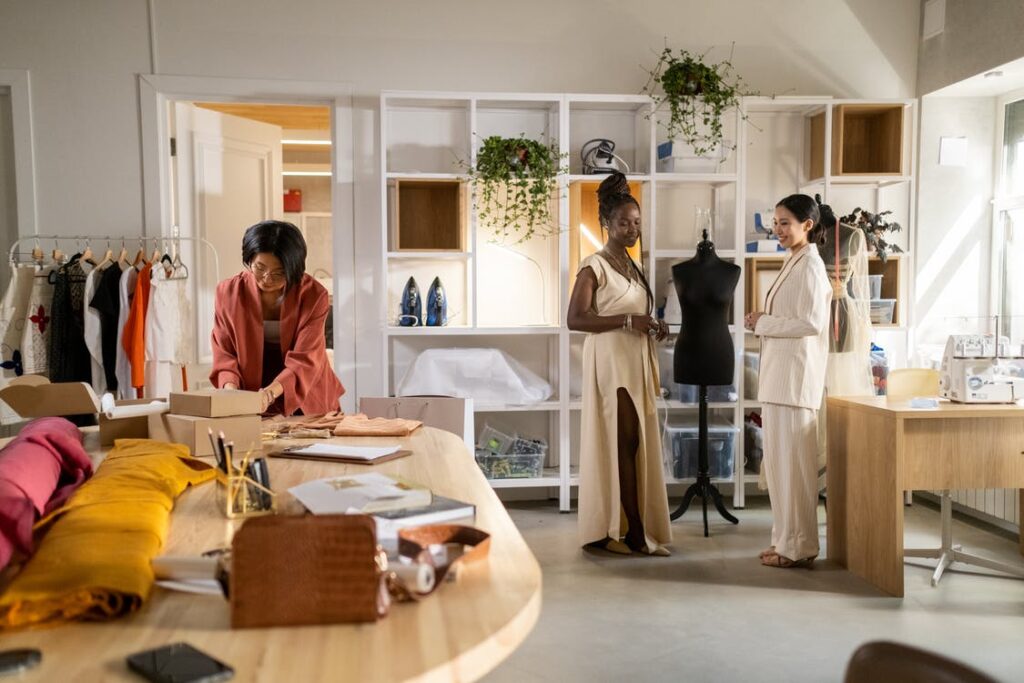A 2019 Indeed analysis shakes the very foundations of corporate culture, rattling the belief that one must dress appropriately for the job to work as optimally as possible and convey a sense of professionalism to the outside world. The number of companies with strict dress codes is dwindling, thanks, in part, to a reinvigorated workforce desiring a more relaxed vibe in their office attires.
Employers and hiring managers have a decision to make. Either they push with a strict and conservative corporate identity or relax their dress code policies to attract the best talent in the land. It begs one to wonder whether company dress codes are professional or passé or is it a trend that will only go stronger moving forward.
The State of Dress Code
Dress codes exist to guide employees in their choice of work attire.
For example, companies with strict dress codes require their workers to report to work in either a ‘business formal’ or ‘business professional’ attire. Employees cannot wear flip flops, backless tops, yoga pants, artificial hair colors, short dresses or skirts, and other clothing the organization considers inappropriate.
On the other hand, businesses with a more relaxed atmosphere tend to favor casual attire, while others do not have a dress code policy at all.
Hence, it is worth noting that a dress code policy reflects the company’s organizational or business culture.

The Rise of Casual Dress Codes
Interestingly, the New York Times published an article about how many businesses remain steadfast in their dress code policies despite the increasing trend of doing away with such.
The Employers Council says that only one in ten businesses do not observe a dress code for their employees. On the other hand, three out of ten organizations allowed their workers to report to work in business casual attire daily.
Twenty-three percent of firms encouraged their employees to work in a casual dress once weekly, and 22% observed a daily casual dress code. These figures suggest a move towards emancipating employees from corporate-mandated dress requirements.
Bloomberg’s ‘The Death of Clothing’ article delivers an ominous sign to the business attire industry. Makers of suits, neckties, and office dresses complain of dwindling sales. Silicon Valley techies can report to work in a t-shirt covered with a business suit, khaki or denim pants, and sneakers.
Even stalwarts in the finance industry can now wear more comfortable rubber shoes. The organization says that people no longer have to buy separate clothing for work because they can use their everyday clothes for the office.
Robert Half Talent Solutions says more than half (56%) of office employees prefer working in a company with a more relaxed or accommodating dress code. However, two out of five workers are unsure which clothing is appropriate and which ones are not, suggesting unclear dress code policies.
The number of companies with strict dress codes is dwindling. According to the Society for Human Resource Management, one in two US companies now allow their employees to dress casually every day. The adoption rate was only 32% five years ago. More interestingly, about two in three (62%) businesses now permit their workers to wear casual attire at least once weekly.
The phenomenon is not exclusive to small businesses. The National Public Radio reported that Goldman Sachs started relaxing its dress code policies in early 2019. The Wall Street titan now expects its financial advisors and consultants to ‘dress according to client expectations.’
The firm says the move should improve client confidence and comfort with the investment team. Industry experts say Goldman Sachs’ move reflects its recruitment strategy, focusing on getting the top talents from Facebook, Google, and other Silicon Valley stalwarts. Unsurprisingly, these West Coast organizations are famous for their relaxed work clothing.
Minneapolis-based retail giant, Target, was quicker to revise its dress code. In 2014, the business implemented the ‘dress for your day’ policy, allowing its employees to wear whatever they feel comfortable. Today, Target employees can wear jeans on weekends.
Virgin Atlantic also relaxed its dress code, especially for its female flight attendants. Makeup is no longer mandatory, and so are tight-fitting skirts. Female flight attendants can don pants like their male counterparts. The airliner says the move empowers its employees to express their individuality, offering more choices and increasing comfort levels.

More and more companies with strict dress codes are relaxing their policies, introducing incremental improvements over time. Whether it is the choice between dress shoes and sneakers or dress pants versus jeans, companies now recognize the value of empowering their employees to choose what they want to wear to work.
As long as the choices do not undermine employee safety and customer trust and confidence, people can expect more businesses to rethink their dress codes and make them more comfortable and convenient.
You might also like: What’s the Importance of Attention to Detail 2022?
Companies with Strict Dress Codes: Dress Code and the Recruitment and Hiring Process
Unsurprisingly, a company’s dress code matters even before someone become an employee. An NVision study revealed that a candidate’s grooming and appearance are in the top five things-to-look-for of job interviewers. More than nine out of ten (90.8%) female interviewers look at a job applicant’s dress and grooming during interviews, while 83.3% of male interviewers do so.
More than three out of four (76%) interviewers also look at a job candidate’s attractiveness. Three-quarters of interviewers consider stylish attires matters in the pre-employment process, with 32.7% of female and 30.4% of male interviewers holding this value extremely high.
Sadly, more than one out of five (21%) interviewers would pick a job candidate who flaunts her sex appeal. It might sound sexist, but these are facts that employers and HR professionals must recognize and address.
There is a good reason why recruiters and hiring managers think that an appropriately dressed and well-groomed job candidate is perfect for a post. Studies show that wearing formal clothing to job interviews can influence interviewers’ perceptions of the candidate’s cognitive abilities. Research indicates that a formal attire increases action identification, category inclusiveness, and global processing.
An Association for Psychological Science article also supports the notion that wearing formal clothes to an interview can influence hiring decisions. The report also says that business attire can impact people’s thinking. These studies are what companies with strict dress codes adhere to.
However, other experts say these are perceptions and are not a true measure of someone’s cognitive aptitude. A case in point is Apple’s founder, Steve Jobs, who is well-known for his laidback fashion. The world sees the tech wizard as a lover of black turtlenecks, a classic-fit Levi’s 501, and New Balance sneakers. Harvey Spectre would frown on Job’s choice of attire, yet no one will argue that Steve has one of the most creative minds on the planet.
There is also the 2012 CNN report that depicted Facebook founder, Mark Zuckerberg, meeting potential investors dressed in his now-iconic hoodie. Wall Street stalwarts frowned on the idea of a casually-dressed twenty-something steering a multi-million dollar corporation, with many investors saying Zuckerberg is too immature.
It is nothing compared to Zuckerberg’s well-publicized venture capital firm meeting wearing his pajamas. Regardless of Zuckerberg’s choice of attire, Facebook became one of the fastest-growing companies in the 21st-century. Facebook started with an initial public offering of $38 in May 2012. Today, it hovers above $223, peaking at $384 and dipping to a low $219.77.
Whoever says a person’s manner of dressing is a powerful predictor of his job performance or success does not know Steve Jobs, Mark Zuckerberg, and other successful people. Interviewers risk losing the best talent if they rely solely on a job candidate’s appearance without assessing his cognitive aptitude, personality, attitude, and other characteristics before deciding.
Companies with Strict Dress Codes: Why Most Companies Adhere to a Strict Dress Code
Although data suggests a growing trend towards a more casual dress code, about half of businesses choose to retain a strict dress code. The following are the most often cited reasons.
Establishes Corporate Brand
Companies with strict dress codes cite corporate branding as the principal reason for requiring employees to wear a uniform or any attire the company deems reflective of the brand. Uniforms are an integral part of an organization’s culture, enabling their customers to differentiate them from other brands.
Uniform branding has advantages for companies. It includes brand promotion, the creation of a professional business image, and the prevention of cross-contamination between products. It can also enhance brand recall, facilitate customer relationships, and foster team spirit.

Influences Work Performance
The joint research by Columbia University and California State University-Northridge provides companies with strict dress codes with another reason not to abandon their policies. The meta-analysis revealed that a formal dress code enhances abstract cognitive processing. It also underscored the importance of formal attire in improving self-perception, allowing employees to feel more confident in their work performance.
Most people think highly of well-dressed people, invoking an image of professionalism and high cognitive ability. It fuels employees’ self-perception, reinvigorating their desire to perform beyond expectations.
Establishes Work Cohesion and Consistency
Some employers believe that a strict dress code makes their employees look cohesive, producing a unified front when facing customers and deflecting tirades from competitors. It allows employees to feel they belong to a group, promoting confidence in their abilities as a team.
Companies also believe that a clearly-stated policy on business attire supports positive work practices and career growth. Companies with strict dress codes give employees clear directives on what they can and cannot wear to work. It avoids confusion, especially since 47% of people do not accurately understand what ‘business casual’ means.
Ensures Employee Safety
Some professions and industries have stricter dress codes than others because of safety reasons. For example, workers in the automotive industry must wear overalls, personal protective equipment, and jackets to keep them safe against sharp objects, sparks, and hazardous chemicals.
On the other hand, construction workers require safety helmets, safety boots, thick gloves, and similar attire. Wearing these articles help avoid costly accidents due to harsh chemical exposure, bruises, cuts, and more.
Members of the security industry also have specific requirements for their dress code. Law enforcement officers and military personnel have a strict dress code because it protects them in their job while also enabling the carrying of multiple resources.
Distinguishes Employees from Customers
Companies with strict dress codes often want to differentiate their employees from customers. For example, it would be challenging to spot a worker at an event filled with clients if the employees wear ordinary clothes.
Not everyone agrees with these points. Detractors say that strict dress codes hinder employee engagement and stifle creativity. It sends a veiled message of distrust – telling people what they can and cannot wear signals that the company does not trust its employees to dress appropriately. Proponents of casual dress codes say that a more lenient policy about workplace attire can promote employee self-expression. In turn, it can encourage creativity and foster productivity in the workplace.
There is also the issue of gender-based discrimination. For example, female workers can wear shoes with open toes while males cannot. Female employees can also sport multiple ear piercings and long hair and expose some of their legs. Some companies require female employees to wear high heels. In the UK, a female employee lost her job for refusing to wear high heels in the office. The fired employee initiated a signature campaign calling on the British Parliament to discuss sexist policies.
Why Some Brands Prefer a More Casual Dress Code
More and more organizations are willing to relax their dress code policies. Everything started in the 1990s when companies began offering employees the inexpensive benefit of wearing business casual every Friday. Today’s casual dress code is more t-shirts and sneakers. The following are the top three reasons some brands prefer a more casual dress code.
Increases Chances of Landing the Best Talent
Even before the ‘Casual Fridays’ of the 1990s, tech firms of the 1980s had to think of more ingenious ways to attract top talent. According to TALiNT International, more than three out of five (61%) of job seekers have a negative perception and attitude towards companies with strict dress codes. Forbes says that millennials are driving the observation, making it the ideal recruiting tactic for organizations that want the best talent from the Millennials generation.
The Millennial generation of employees has highly intuitive knowledge of technological advances. They are also open to change and are especially adept at adapting. Millennials are creative, free-thinking, passionate about learning, and openly receptive to recognition and feedback. Although they can challenge the status quo, Millennials value workplace social interactions and meaningful motivation.
Unsurprisingly, many forward-thinking businesses actively look for and hire Millennials because they bring companies a fresh perspective and are culturally involved. With the boom in digital transformation, it is hard to imagine a company preferring a Baby Boomer over a Millennial.

Promotes Organizational Culture Change
Changing an organization’s business culture is one of the most challenging aspects of leadership. However, organizational culture change is necessary amidst behavior changes, technological advancements, changing workforce characteristics, economic transformations, tensions, market competitor pressure, and crises. Adopting a more relaxed dress code is one of the easiest ways to facilitate organizational culture change.
A case in point is JPMorgan Chase which created an office specially organized for its tech workers. It has foosball tables and whiteboard walls, and the company decided to ditch suits and neckties for more casual attire.
Promotes Employee Satisfaction, Motivation, and Happiness
Collaboration between The Business of Fashion and Thrive Global surveyed 2,700 employees across 20 countries about dress codes in their respective organizations. Unsurprisingly, more than half (55%) of the respondents do not feel their work attire accurately represents their true selves, leading to discontent, reduced motivation, low satisfaction, and unhappiness.
Employers cannot expect unhappy and unsatisfied employees to work their absolute best. It can undermine the company’s operations, produce unfavorable outcomes, and lead to employee disillusionment and disengagement.
Detractors of casual dress codes argue that lenient policies do not convey a sense of professionalism. Employees can also misinterpret ambiguous language.
Why a Few Organizations Do Not Have a Dress Code at All
Lifehack says a few businesses have done away with the dress code to make employees feel more comfortable at work and promote increased creativity and productivity. These organizations also cite dress codes as obstacles to building and nurturing trust between employers and employees, while also impeding transparency. Eliminating dress codes enables businesses to move forward from anachronism.
Unfortunately, an office without a dress code might look unprofessional, disorganized, and careless. People might view these businesses as lowly because they feel the organization lacks the competencies seen in well-dressed employees.
Legal Implications of Dress Codes
Companies with strict dress codes: There are no federal laws that penalize employers for having strict dress codes. However, employment discrimination lawsuits are on the rise. Companies cannot take for granted special requests for exemptions to certain dress codes because of health, disability, religious, cultural, gender, and appearance issues.
For instance, a worker with diabetes-related foot problems can seek exemption from wearing tight-fitting shoes. A company cannot force an employee to wear attire that contradicts the employee’s religious beliefs.
Final Thoughts on Companies with Strict Dress Codes
Companies can decide to ditch their strict dress codes and adopt a more relaxed policy or remain staunch in their age-old tradition. Regardless of the dress code, business owners must recognize and appreciate legal requirements for ensuring fair employment practices. It is also crucial for organizations to guarantee an inclusive and productive work environment, regardless of the dress code they observe and implement.
Photo credit Pexels

1 comment
[…] locations has caused many companies to alter their values when it comes to dress codes. In fact, 22% of companies encourage daily casual wear at work – meaning less pressure is placed on employees to adopt workwear, and so this might see women’s […]